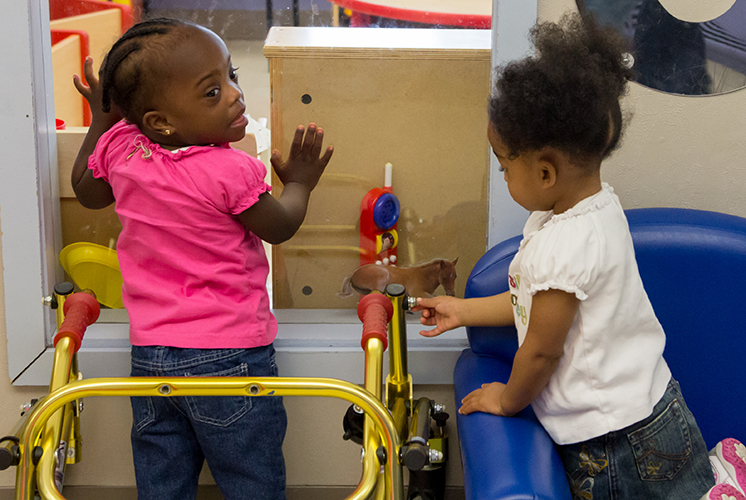
Practices that support effective, engaging, and accessible environments refer to age-appropriate equipment, materials, supplies, and physical spaces. Environments also include developmentally appropriate schedules, lesson plans, and experiences that practitioners and families can alter to make necessary accommodations to support all children, especially those at risk for or diagnosed with disabilities.
These practices are aligned with the Head Start Early Learning Outcomes Framework (ELOF) in the following domains: Approaches to Learning; Social and Emotional Development; and Perceptual, Motor, and Physical Development. Learn more about recommended practices related to environment from the Division for Early Childhood (DEC).
Resources for each topic area are organized based on their level of impact for learning. The resources provided are only a sampling of the resources available on these practices.
Knowledge Awareness Level
Resources that fall into this category provide basic information and do not include activities that draw participants in to respond or reflect. They include archived webinar recordings and checklists.
Activity Simplification
Watch this in-service suite to discover strategies for simplifying activities to increase participation of children who need more support or challenge. Links to supporting materials are provided, including tips, tools, and resources for teachers, supervisors, and trainers.
Child Preferences
This in-service suite offers strategies for using child preferences to help increase the participation of children who need more support or challenge. Links to supporting materials are provided, including tips, tools, and resources for teachers, supervisors, and trainers.
Environmental Support
This in-service suite offers strategies for using environmental support to help increase the participation of children who need more support or challenge. Links to supporting materials are provided, including tips, tools, and resources for teachers, supervisors, and trainers.
Environment Checklists and Practice Guides for Practitioners and Families
Learn more about using the DEC Recommended Practices on environment. The checklists cover Natural Environment Learning Opportunities, Environmental Arrangements, Child Physical Activity, Environmental Adaptations, and Assistive Technology. Practice Guides for practitioners and families address several components of environment, including classroom learning opportunities, learning within reach or on the go, access to learning at home, supporting children's learning, and more.
Integration Checklist: Including Children with Significant Disabilities in Head Start
This checklist helps disabilities coordinators, teachers, and staff members ensure that children with significant disabilities are included in Head Start program and classroom routines and activities to the maximum extent possible.
Let's Talk About Routines
This Caring Connections podcast looks at the value of predictable routines to help young children build a sense of trust and security. Home visitors and child care providers will hear tips for creating meaningful routines.
Materials Adaptation
Find strategies for using material adaptations to help increase the classroom participation of children who need more support or challenge. Links to supporting materials are provided, including tips, tools, and resources for teachers, supervisors, and trainers.
Knowledge Acquisition Level
The resources below include information and activities that draw participants in to respond or reflect.
Activity Matrix: Organizing Learning Throughout the Day
This in-service suite introduces the Activity Matrix as an effective tool teachers can use to organize learning opportunities for children who need additional support during daily classroom activities and routines. Examples of how the matrix can be used with children’s individual learning goals are shared. Supporting materials for teachers, supervisors, and trainers include tips, tools, and helpful resources.
Curriculum Modifications: An Introduction
See an overview of eight types of curriculum modifications. Teachers can make these simple changes to classroom activities to increase a child’s engagement and learning.
Highly Individualized Teaching and Learning: An Overview
Watch a short video and explore supporting materials about the levels of individualization that may be appropriate for children with diverse strengths and needs. The video briefly describes three ways that teachers can individualize their teaching: making simple modifications; providing many embedded learning opportunities; and using more intensive teaching practices. Supporting materials include tips, tools, and resources for teachers, supervisors, and trainers.
Mastery Level
Coaches, faculty, and professional development providers can use these resources to teach content to and support others in developing knowledge and skills application related to the content.
CONNECT Module 5: Assistive Technology
Explore the purpose, use, and potential benefits of including assistive technology in the classroom. Find out how it can support access and participation in everyday learning opportunities for children with disabilities. CONNECT Modules start with a real-life dilemma and include video demonstrations of the practice, a research brief, activities, and practice checklists. The modules are also available in Spanish.
« Go to Resources Supporting Individualization
Read more:
Resource Type: Article
National Centers: Early Childhood Development, Teaching and Learning
Audience: Teachers and Caregivers
Last Updated: February 27, 2025
